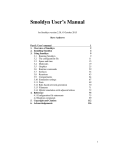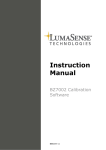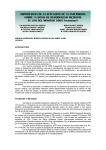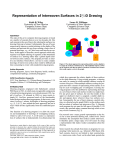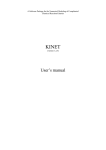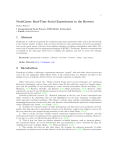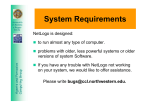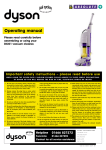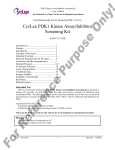Download Connected Chemistry - Center for Connected Learning and
Transcript
Recent advances in educational technologies have attempted to improve students understanding, retention, and application of kno 7/1/09 2:54 PM Connected Chemistry– Incorporating Interactive Simulations into the Chemistry Classroom Mike Stieff [1] Uri Wilensky 1 To appear in Journal of Science Education and Technology Please do not circulate or quote without authors' permission Suggested Running Head: Connected Chemistry Corresponding Author's Mailing Address: Mike Stieff 2120 Campus Drive/Rm. 318 Northwestern University Evanston, IL 60208 ABSTRACT The aim of this article is to describe a novel modeling and simulation package, Connected Chemistry, and assess its impact on students' understanding of chemistry. Connected Chemistry was implemented inside the NetLogo modeling environment. Its design goal is to present a variety of chemistry concepts from the perspective of "emergent phenomena"-- that is, how macro-level patterns in chemistry result from the interactions of many molecules on a submicro-level. The Connected Chemistry modeling environment provides students with the opportunity to observe and explore these interactions in a simulated environment that enables them to develop a deeper understanding of chemistry concepts and processes in both the classroom and laboratory. Here, we present the conceptual foundations of instruction using Connected Chemistry and the results of a small study that explored its potential benefits. A three-part, 90-minute interview was administered to six undergraduate science majors regarding the concept of chemical equilibrium. Several commonly reported misconceptions about chemical equilibrium arose during the interview. Prior to their interaction with Connected Chemistry, students relied on memorized facts to explain chemical equilibrium and rigid procedures to solve chemical equilibrium problems. Using Connected Chemistry students employed problem solving techniques characterized by stronger attempts at conceptual understanding and logical reasoning. KEYWORDS: Chemistry Education, Modeling Environments, Scientific Visualization INTRODUCTION Many students view chemistry as one of the most difficult subjects to study at all levels of schooling. Learning chemistry places many demands on students and teachers that can seem insurmountable. Instructors display mathematical formulas, chemical http://ccl.northwestern.edu/papers/connected-chemistry/#references Page 1 of 28 Recent advances in educational technologies have attempted to improve students understanding, retention, and application of kno 7/1/09 2:54 PM places many demands on students and teachers that can seem insurmountable. Instructors display mathematical formulas, chemical symbols and scientific measurements simultaneously to describe phenomena that are not readily apparent to students. Moreover, the concepts of chemistry are often seen as abstractions confined to the chemistry classroom and not applicable outside of school. To deal with such difficulties, chemistry educators have devoted considerable time to developing curricula that help students visualize the molecular world and connect classroom concepts to observable phenomena. In particular, a few novel curricula employ computerbased learning environments, such as 4M:Chem (Kozma et al., 1996) and eChem (Wu, Krajcik & Soloway, 2001), as visualization tools with which students reason about chemistry. Building on these previous efforts, this paper introduces a new computer-based modeling environment for learning chemistry. The modeling environment, Connected Chemistry, uses a "glass box" approach (Wilensky, 1999a) that not only enables students to visualize the molecular world but also provides them with virtually unlimited opportunities to interact with and to manipulate a simulated molecular world to gain a deeper understanding of core chemistry concepts and phenomena. Here, we present the conceptual underpinnings and structure of Connected Chemistry and some findings regarding the affordances of using Connected Chemistry to learn about the concept of chemical equilibrium. Conceptual Difficulties in Chemistry Education Considerable research has been devoted to identifying and classifying student misconceptions in chemistry. The majority of this work attempts to highlight where student understanding differs from accepted scientific concepts in order to aid instructors in the development of new curricula that bring students more rapidly to a desired understanding (Quílez-Pardo & Solaz-Portolés, 1995; Tyson & Treagust, 1999; Voska & Heikkinen, 2000). To this end, educational researchers have underscored how traditional chemistry curricula, replete with lectures and drill-and-practice exercises, are unsuccessful at providing students with a solid conceptual understanding of the theories and expressions found in chemistry (Kozma et al., 1990; Johnstone, 1993; Thomas & Schwarz, 1998). Unfortunately, despite decades of research and curriculum development, modern students still do not adequately learn the necessary concepts to succeed in chemistry (Nakleh, 1992; Tyson & Treagust, 1999). Some current researchers have begun to look beyond the classification of misconceptions toward understanding what underlies the difficulties that students have when approaching complex topics such as chemical equilibrium, molecular orbital theory or reaction kinetics. In particular, chemistry education research has shifted focus to explore students' particular difficulties with understanding the representations of chemical phenomena at multiple levels as well as the forms chemists give those representations. Experienced chemists take for granted that chemical phenomena occur at multiple levels -- the submicroscopic, the macroscopic and the symbolic (Johnstone, 1993). Because interactions between molecules and atoms occur at a submicroscopic level, chemists must Page 2 of 28 http://ccl.northwestern.edu/papers/connected-chemistry/#references Recent advances in educational technologies have attempted to improve students understanding, retention, and application of kno 7/1/09 2:54 PM the symbolic (Johnstone, 1993). Because interactions between molecules and atoms occur at a submicroscopic level, chemists must refer to the objects and processes within their domain, which they cannot observe directly, at a symbolic level. Moreover, aggregations of molecules result in phenomena at a macroscopic level, which students can directly observe, such as when water freezes or ice melts. Here again, for the purposes of clarity and concision, chemists represent these macroscopic phenomena at the symbolic level. At this level, where most teaching and learning take place in the traditional chemistry classroom, instructors can use multiple representations to describe the same phenomena (Kozma & Russell, 1997). A particular chemical reaction may be represented with letters, molecular diagrams or plots of concentration over time. In the laboratory, students are further expected to connect the symbolic representations in texts to the macroscopic physical substances they use in an experiment and the numerical measurements they take from laboratory instruments. Although chemists may easily discern the relationships between chemical phenomena at the symbolic, submicroscopic, and macroscopic levels and represent the phenomena with several representations, students have considerably more difficulty (Banerjee, 1995). One curriculum design approach that has enjoyed much success in directly addressing the conceptual difficulties of chemistry utilizes computer animations of chemical reactions to highlight the relationships between the various representations and levels (Kozma et al., 1996). These computer-based curricula provide an opportunity for inquiry-based approaches to teaching chemistry. Curricula of this nature provide students with a learning environment in which they can study a concept as it relates to a particular system, be it a chemical reaction or an evolutionary ladder, make predictions about that system, and justify their predictions with observable outcomes (Barowy & Roberts, 1999). This approach discourages rote memorization and algorithmic problem solving, while encouraging conceptual understanding and critical thinking during problem solving (Garnett & Kenneth, 1988). The inquiry approach has seen much success in many science domains, and many chemistry educators now advocate for its use in the chemistry classroom (Bodner, 1992; Copolo & Hounshell, 1995). In the chemistry classroom, computer-based learning environments attempt to make explicit the information embedded in traditional molecular representations as well as to provide a visual representation of molecular interactions for students to observe. Such software provides the student with "multiple, linked representations" that foster conceptual understanding and emphasize the connections between symbolic representations to aid problem solving (Kozma et al., 1996. p. 41). Here students learn chemistry by viewing molecular animations side-by-side with graphical outputs and chemical formulas. This is in stark contrast to traditional chemistry lectures that almost exclusively rely on verbal explanations of concepts in which students have no opportunity to observe molecular interactions. Because, in the computer-based environment, students can manipulate various parameters of the chemical http://ccl.northwestern.edu/papers/connected-chemistry/#references reaction under study, they can make predictions based on 3 of 28 their understanding of relevant chemistry concepts. Consequently, Page students Recent advances in educational technologies have attempted to improve students understanding, retention, and application of kno 7/1/09 2:54 PM reaction under study, they can make predictions based on their understanding of relevant chemistry concepts. Consequently, students can monitor their own learning by observing the results of their manipulations of system variables. Teaching Chemistry Concepts as Emergent Phenomena Though computer-based learning environments for chemistry have resulted in improved student understanding (Wu, Krajcik, & Soloway, 2001), much of the current software is "first generation" and does not yet fully employ an inquiry approach to teaching chemistry. Primarily, much of the software currently available is limited by "black-box" designs. These packages come with a predefined number of models, a small number of activities for teachers and minor learning goals for students. Students are given a limited number of macroscopic variables, which they can only manipulate in predefined ways. Moreover, the molecular visualizations that give students access to submicroscopic interactions between molecules are often delivered as simple animations: for each set of variables that a student selects, one particular animation repeatedly displays. These characteristics both reduce the fidelity of these environments as simulations of actual chemical phenomena and limit their use as inquiry tools with which students can make hypotheses and explore outcomes. To overcome these limitations, we suggest that a better approach to the design of computer-based learning environments for chemistry rests on the idea of teaching chemistry from the perspective of emergent phenomena. The concept of emergent phenomena recognizes that patterns observed on a macro-level "emerge" from the interactions between many agents on a micro-level according to specific rules that govern individual micro-level agents' behavior (Wilensky, 2000, 2001). For instance, the specific submicroscopic interactions between many billions of molecules in a drop of water result in the macroscopic physical state of the water. When the water molecules move at relatively high velocities and their interactions are elastic collisions, steam is observed on the macro-level. Conversely, when the water molecules do not move, but vibrate in place, and maintain contact with each other through strong hydrogen-bonding interactions, the observer sees solid ice. Though these examples are commonplace, our chemistry curricula have not been designed to let students link the "rules" at the micro-level with their everyday experience at the macro-level. In Connected Chemistry, we give students access to the rules that govern the individual behavior of molecules. Students can then visualize and explore how macro-level theories and concepts of the classroom emerge from molecular interactions on the submicroscopic level. We believe that learning chemistry from this perspective will both enhance students' understanding of particular chemistry concepts and improve their problem solving skills across a variety of chemistry topics. By conceiving of chemistry concepts as emergent phenomena, students will gain additional avenues for reasoning about chemistry beyond simple application of http://ccl.northwestern.edu/papers/connected-chemistry/#references Page 4 of 28 Recent advances in educational technologies have attempted to improve students understanding, retention, and application of kno 7/1/09 2:54 PM rote procedures and memorized facts. Next, we present the modeling environment, Connected Chemistry, specifically designed to teach a variety of chemistry concepts as emergent phenomena in both secondary and undergraduate classrooms. THE LEARNING ENVIRONMENT: CONNECTED CHEMISTRY Connected Chemistry consists of a number of computer-based models written in the multi-agent modeling language (MAML) NetLogo (Wilensky, 1999b). The NetLogo language has been employed in a variety of biology and physics classrooms (e.g. Wilensky & Reisman, 1999, in press; Wilensky et al., 1999) to help students understand how micro-level interactions between individual agents can result in observable patterns at the macro-level. Frequently, in a traditional classroom, these observable patterns are taught as isolated concepts and laws that students are required to memorize (Wilensky, 2000). In MAML environments, students can control the behavior of thousands of graphical "agents". By exploring the relationship between the agents' rules of behavior and the patterns that emerge as a result of these rules, students are able to eliminate many misconceptions that are generated by confusing their understandings of micro- and macro-level interactions. Typically, in curricula using multi-agent modeling (e.g., GasLab (Wilensky, 1999a), EACH (Centola et al., 2000)), students begin by exploring the behavior of pre-built simulations designed to focus on some target concepts. They make predictions about the behavior of the model under varying model parameters then test their predictions by exploring model outcomes as they manipulate variables in a simple graphical user interface. Students, however, may at any time open up the "black box" of the interface and examine (and change) the underlying rules that control the individual elements of the model. The Connected Chemistry package consists of several such pre-built models[2] designed for teaching target chemistry concepts. Each of the models simulates a closed chemical system that students can interact with in several ways. The core of every Connected Chemistry model is the interface window (Figure 1). Typically, the interface contains a graphics window, a plotting window and several variables in the form of sliders and buttons that students can manipulate. It is here in the interface window that students can observe directly the interaction between the submicro- and macro-levels of chemistry. The graphics window is where students can observe a visual representation of the interactions between simulated molecules in a sealed container. The motion and interactions of the molecules in the graphics window result from all of the molecules executing, in parallel, the individual rules that govern their behavior; it is not a static animation linked to manufactured states of the reaction. For instance, when a student alters the temperature of the system, each molecule individual responds to the temperature change-it is not a simple transition to a separate animation. Rather than merely displaying a new animation of molecular motion at a higher temperature, each molecule changes its behavior as if heat has been applied to the boundaries of the closed system. When a molecule collides with the http://ccl.northwestern.edu/papers/connected-chemistry/#references Page 5 of 28 Recent advances in educational technologies have attempted to improve students understanding, retention, and application of kno 7/1/09 2:54 PM heated boundary, it absorbs some quantum of energy. Consequently, each molecule that collides with the boundary increases its speed in proportion to the amount of energy it absorbs, independent of the other molecules in the system. Thus, the primary affordance of the graphics window is that students can observe directly how changes in macroscopic variables (e.g. adjustments to temperature, concentration, etc.), which they make, affect the submicroscopic interactions of the molecular species that, in turn, perturb macroscopic graphs of variables such as concentration, pH or pressure. So that students can observe the effects of their manipulations of the system on macroscopic variables, each interface window includes at least one plotting window. A basic plotting window in a Connected Chemistry model typically displays the relative concentrations of each chemical substance in the system in real-time as the simulation runs. The concentration of a substance is a macro-level quantity of measurement that is defined in Connected Chemistry by the number of molecules of a particular chemical species relative to the total number of molecules in the system, which parallels the macroscopic concept of molarity (i.e. moles of a dissolved substance relative to the total volume of a solution). Once the simulation begins, the system quickly reaches a steady-state equilibrium, which students can observe (and perturb) in both the graphics window and simultaneously in the concentration plot. Were the model confined to demonstrating the properties of the system in either window alone, it would be severely limited. A fundamental asset of Connected Chemistry as a learning tool for chemistry comes from the fact that students can interact with the system to modify system parameters and receive instant feedback about their predictions with multiple representations on multiple levels. Many Connected Chemistry models contain additional plot windows for students to observe a variety of phenomena such as changes in pH over time, changes in pressure due to concentration and changes in concentration of a reaction product due to changes in the amount of added catalyst. http://ccl.northwestern.edu/papers/connected-chemistry/#references Page 6 of 28 Recent advances in educational technologies have attempted to improve students understanding, retention, and application of kno 7/1/09 2:54 PM Figure 1. Connected Chemistry's interface window contains a graphics display, plot outputs and system parameters. For instance, in the "Simple Kinetics 1" model (shown in Figure 1), students can observe in the graphics window how a collision between two nitrogen dioxide molecules, under favorable conditions, can produce one dinitrogen tetroxide molecule. As a result, the macro-level representations of the chemical species change. In the graphics window there is an increase in the number of dinitrogen tetroxide molecules, and in the plotting window, the concentration plot of dinitrogen tetroxide also increases while that of dinitrogen monoxide decreases. By manipulating the sliders for predefined system variables in "Simple Kinetics 1", students can also observe how varying the rate constants for the reactions alters molecular behavior and consequently the concentration plot. Connected Chemistry models are not limited to the predefined variables of the software designers, however. The models are extremely malleable: Students can add or remove variables from the interface window to explore thoroughly the behavior of a chemical system under a variety of conditions. As mentioned previously, a critical advantage of Connected Chemistry over other computer-based inquiry environments is that each model is built as a "glass-box". Each model contains an information window (Figure 2) that contains a description of the chemistry concepts underlying the model, instructions on how to use the interface window and some suggested modifications of the procedures. As described earlier, students can manipulate the variables that are provided in the interface window and explore the resultant model behavior. But Connected Chemistry also enables students to go one level deeper. In the procedures window (Figure 3) they can also examine and alter the NetLogo programming code that governs molecular behavior. The NetLogo code is easily accessible and comprehensible, which enables students to "read" the rules that the molecules obey and, if they wish, to later modify them. The Connected Chemistry documentation encourages instructors and students to modify procedures and observe how the chemical system is affected. For example, students might alter the procedures so that they can inject more chemical reactants or products into the system as the simulation runs. http://ccl.northwestern.edu/papers/connected-chemistry/#references Page 7 of 28 Recent advances in educational technologies have attempted to improve students understanding, retention, and application of kno 7/1/09 2:54 PM Figure 2. The information window of each Connected Chemistry model contains a summary of the chemistry concepts highlighted by the model as well as instruction on how to use the model and suggestions on how to manipulate the NetLogo code to further explore the simulated chemical system. Though at first it may seem daunting to alter the NetLogo code, each model comes with several supports for students and teachers. First, each Connected Chemistry model comes packaged with an on-line tutorial and user-manual for the NetLogo modeling language. NetLogo stresses natural language programming, and using the on-line tutorial many students are able to design novel models in less than a week. Second, the procedures window (Figure 3) of each Connected Chemistry model is immediately accessible from the interface window so that students can investigate the procedures that underlie the visual displays of the graphics and plotting windows. Moreover, the procedures listed in the procedures window are fully annotated with concise comments that explain how the particular code used results in the observed behavior of the interface window. Third, the information window of each Connected Chemistry model contains a section entitled "Extending The Model" that provides suggestions to students about how they might alter the code to further explore the chemistry concepts emphasized by the model. The immediate access to and straightforward language of the underlying procedures provides a significant advantage to chemistry students. This glass-box design of Connected Chemistry allows students to explore concepts outside the initial boundaries of each model. Thus, novel problems and spontaneous questions can easily be addressed as they occur in the classroom. With minor alterations of the interface window or procedures, students can introduce new variables into a model to test their predictions. For example, students working with the "Simple Kinetics 1" model may decide to alter the procedures so that three molecules of nitrogen monoxide must collide in order to form one molecule of dinitrogen tetroxide. After making their modifications to the procedure window, the students can then observe how their alterations affect the rate of the reaction and the concentration of each chemical species over time. Working with their instructor the students might further discuss the differences between bimolecular and trimolecular reactions and whether the students' novel chemical system could actually http://ccl.northwestern.edu/papers/connected-chemistry/#references Page 8 of 28 Recent advances in educational technologies have attempted to improve students understanding, retention, and application of kno 7/1/09 2:54 PM discuss the differences between bimolecular and trimolecular reactions and whether the students' novel chemical system could actually occur in the real-world given their knowledge of kinetics (and stoichiometry). Together the procedures window, the interface window and the information window draw together the submicro-, macro- and symbolic levels of chemistry so that students are not forced to rely on only one level or representation. Figure 3. In the procedures window, each Connected Chemistry model provides students with access to the code that drives the simulation. The NetLogo modeling language of Connected Chemistry is uncomplicated, and annotations in the procedure window explicitly explain the purpose of each procedure to students. POTENTIAL BENEFITS OF USING CONNECTED CHEMISTRY To explore the benefits of the Connected Chemistry learning environment for helping students understand chemistry, we conducted a small study with six undergraduate students at a large research university. In particular, we were interested in observing whether Connected Chemistry provoked changes in students' understanding of the concept of chemical equilibrium. Although Connected Chemistry is designed primarily for use in an introductory chemistry course at the secondary level, we conducted the current study with undergraduate science students in order to measure the success of the software with students well versed in the concept of chemical equilibrium. While it is true that these six students might possess both more domain knowledge and more advanced problem-solving skills than secondary students, subsequent ongoing work with secondary students suggests that Connected Chemistry possesses the same opportunities for both populations. Our goal here was to observe whether Connected Chemistry provided significant benefits to the advanced students, which would warrant a larger implementation study at the secondary level. http://ccl.northwestern.edu/papers/connected-chemistry/#references Page 9 of 28 Recent advances in educational technologies have attempted to improve students understanding, retention, and application of kno 7/1/09 2:54 PM Study Participants Each of the students interviewed in this study was self-described as high achieving in the sciences, particularly chemistry and biology. Of the six undergraduates, two were fourth-year students who intended to pursue doctoral work in biochemistry and molecular biology. Of the other four students, all of whom intended to pursue degrees in medicine, two were third-year students and two were fourth-year students. All six of the students reported originally learning about chemical equilibrium in introductory high school chemistry and that they had not covered the concept again explicitly in any of their higher-level chemistry courses. Each student had successful completed undergraduate courses in General Chemistry, Organic Chemistry, and Biochemistry with a greater than B average. Before the start of the interview, each student claimed to be familiar with the concept of chemical equilibrium. Study Protocol The protocol for the study consisted of three separate segments in a 90-minute interview (see Table I; for a full outline of the interview protocol, please see Appendix I). The first segment of the interview aimed to uncover each participant's recall and understanding of chemical equilibrium. For this, participants were asked various questions that allowed them to explain, in their own words, chemical equilibrium and any information they felt was important to the concept. The second portion of the interview attempted to discover each participant's ability to apply chemical equilibrium concepts to traditional textbook questions. The final portion of the interview protocol required students to make predictions about the equilibrium state and position of a particular reaction, 2NO2 N 2 O 4 , which they then demonstrated using the Connected Chemistry model, "Chemical Equilibrium 1". For each question in the final segment of the interview, participants were given an initial set of conditions for the system followed by a final set of conditions in which one or two system parameters were changed while the others remained constant. The simulation was first run using the set of initial conditions and participants would observe the molecular interactions. The interviewer would then pose a question about how the system would change if the system variables were altered and the participants would make predictions. The participants then manipulated the system variables as defined by the interviewer's question, after which they would explain their observations of the system and compare them with their initial predictions. The first two segments together comprised 45 minutes of the interview, and the third segment comprised the remaining 45 minutes. Table I. Format of Protocol Questions Interview Segment Recall and Explain Chemical Equilibrium Traditional Problem Solving http://ccl.northwestern.edu/papers/connected-chemistry/#references Example Questions "Define chemical equilibrium." "State factors that can affect reaction equilibrium." Ag2 CO 3 (aq) + 2HCl(aq)<--->2AgCl(s) + H 2 CO 3 (aq) Page 10 of 28 Recent advances in educational technologies have attempted to improve students understanding, retention, and application of kno Problem Solving in Connected Chemistry 7/1/09 2:54 PM "Do the states of each of these substances have any bearing on the equilibrium position of the reaction?" Chemical Equilibrium 1 models 2NO 2 (g) <---> N 2 O 4 (g) "Can you tell by looking at the graphics window only if the system is in equilibrium?" "What else would you need to know?" "What will happen if you decrease the volume of the container?…You decreased it, what happened to the system? Is this what you predicted?" Why Model Chemical Equilibrium? Before detailing the results of our study, it may be helpful to first elaborate on why we chose chemical equilibrium as one of the first concepts to model in Connected Chemistry. The concept of chemical equilibrium and its' related ideas is frequently introduced to students in a high school general chemistry course, where it is often the first and last chemistry course in which the concept is directly addressed (Voska & Heikkinen, 2000). Though chemical equilibrium is rarely taught in higher-level courses, it is a recurrent concept that is vital to understanding many chemical processes not only in chemistry but also biology, medicine and engineering. In fact, chemical equilibrium plays a central role in oxidation-reduction reactions, acid/base behavior, the design of pharmaceuticals and biochemical interactions that underlie many biological processes (Quílez-Pardo & Solaz-Portolés, 1995). Though experienced chemists are so familiar with this concept that they rarely acknowledge it explicitly, educational researchers have found that many students and instructors often find the concept and its accompanying principles difficult to master (Van Driel et al., 1999; Tyson & Treagust, 1999; Banerjee, 1991). Because of the difficulty students have in mastering the concept, there is a critical need for chemistry educators to develop novel curricula that facilitate a better understanding of chemical equilibrium. At its most basic level, the concept of chemical equilibrium requires that students understand the relationships between several physical variables (e.g., pressure, temperature, concentration), several mathematical and symbolic expressions (e.g., reaction quotient, equilibrium constant, rate law), and the equilibrium position (i.e. the relative ratio of reactants and products) of the chemical reaction in question. Typically, students learn the concept of equilibrium by memorizing LeChatelier's Principle, a list of rules for predicting the equilibrium position of a chemical reaction based on the values of the aforementioned physical variables (Tyson & Treagust, 1999; Appendix II contains a summarized version of LeChatelier's Principle). As with many other scientific concepts, the traditional emphasis on fact memorization and rote procedures often results in poor understanding, retention and application of chemical equilibrium concepts (Quílez-Pardo & Solaz-Portolés, 1995). Results Observing the participants' interactions with Connected Chemistry revealed several common misconceptions about chemical http://ccl.northwestern.edu/papers/connected-chemistry/#references equilibrium and incorrect applications of LeChatelier's Page 11 of 28 Principle. Though these misconceptions served as a point of reference from Recent advances in educational technologies have attempted to improve students understanding, retention, and application of kno 7/1/09 2:54 PM equilibrium and incorrect applications of LeChatelier's Principle. Though these misconceptions served as a point of reference from which we observed changes in student thinking and problem solving, we will not detail them here as they have been reported at length elsewhere (Banerjee, 1991; Quílez-Pardo & Solaz-Portolés, 1995). Rather, our observations of student thinking over the course of the interview, most notably during the use of Connected Chemistry, centered on a dramatic change in conception, articulation, and problem solving. Most important, we observed that the participants' dependence on rote procedures for problem-solving and fact memorization, which governed their thinking in the first two stages of the interview, gave way to more thorough attempts at conceptual reasoning and logical justification of answers during their use of Connected Chemistry – a desired result of inquiry-based curricula (Barowy & Roberts, 1999). Moreover, the students' automatic acceptance of information from texts and lectures was replaced by a willingness to question facts and theories in order to validate personally their answers and observations in Connected Chemistry. Such changes in student thinking were especially salient in three distinct categories: (1) defining equilibrium for a chemical system, (2) characterizing factors affecting equilibrium, and (3) transitioning between submicro-, macro- and symbolic levels during problem solving. Equilibrating Thinking about Equilibrium The most prominent effect we observed from participants' interaction with Connected Chemistry was the marked clarifications of the definition of chemical equilibrium that each student made. Difficulty in defining equilibrium is often found among chemistry and biology students when students misconceive of equilibrium as a static state – one in which no change occurs (Banerjee, 1995; Kozma et al., 1990). When a chemical reaction is in equilibrium, the rate of conversion of reactants to products is equal to the rate of conversion of products back into reactants. Thus, at equilibrium the relative concentrations of each molecular species remains constant on the macro-level; however, on the submicro-level, individual molecules are continually converted from reactant to product and back again. Chemical reactions do not stop when they reach equilibrium. Thus, equilibrium is a dynamic process, which many students fail to see because of the stable concentrations of each molecular species. Surprisingly, the students involved in our study had no initial difficulty understanding the dynamic nature of equilibrium. When questioned during the first segment of the interview, each participant stated that although the concentrations of chemical species remained apparently constant, reactions continued on the submicro-level at equilibrium. The following excerpt from the interview with Jane (all references to participants use pseudonyms) typifies participant responses. Interviewer: So, we don't have to have to have the same amount of A and B [reactants] as we do C and D [products] at equilibrium? http://ccl.northwestern.edu/papers/connected-chemistry/#references Page 12 of 28 Recent advances in educational technologies have attempted to improve students understanding, retention, and application of kno Jane: Interviewer: Jane: Interviewer: Jane: Interviewer: Jane: 7/1/09 2:54 PM No. So what is the same at equilibrium? The reaction rate forward and backward. Is the concentration on each side changing at equilibrium? No, it's staying the same. Then is anything changing at equilibrium? Well, yeah. Like some of A and B are going to be C and D and some of C and D are going to be A and B, but the forward and backward [rate] are equal so it all balances out and all the concentrations stay the same. Though at first it appeared that each of our participants possessed a stable, accurate definition of chemical equilibrium, inconsistencies in their conceptual understanding quickly became apparent when they were asked to describe the equilibrium state of specific chemical reactions during the second segment of the interview. While answering questions regarding an equilibrium position and how different variables would affect that equilibrium, the students all had difficulty. Their previously solid definitions and conceptualization of chemical equilibrium fluctuated to depend sometimes on rate and sometimes on concentration. Their reasoning often failed to include vital characteristics of the chemical species in question, such as whether a product boiled out of solution as a vapor. Even when the interviewer pointed out these characteristics, the students had difficulty incorporating the information into their explanations, often declaring that the characteristic was not important. One participant, Andrew, exemplified these common confusions when attempting to predict in which direction Reaction 1 proceeded. Though he correctly answered the question by stating that equilibrium is reached when the competing forward and reverse reaction rates are equal, he became fixated on the macrolevel concentrations of each chemical species and incorrectly changed his answer to depend on those values; in doing so, he completely ignored the role of reaction rate. Ag2 CO 3 + 2HCl (aq) 2AgCl (s)+ H 2 CO 3 (aq) (Reaction 1) Interviewer: Let's say this reaction is frozen in time at specific molar concentrations . . . 10 [Ag 2 CO 3 ], 10 [HCl], 5 [AgCl], and 5 [H2 CO 3 ]. If we start time again, will the reaction change at all or will it stay this way? Andrew: You're going to get production of more product. Interviewer: Why is that? Andrew: Because the molar concentration of Ag2 CO 3 and HCl are a lot higher than what you have on the product side. So it is going to push the reaction forward [to make the products AgCl and H2 CO 3 ]. Interviewer: So, when would it stop or would it stop going this way [to the right]? … You said it would push it this way, would it stop pushing this way ever or will it keep going until all of these [reactants] are gone? Andrew: Well it would stop as soon as the rate of formation of products is equal to the rate of dissociation of those products back to those reactants. Interviewer: What would happen if we started off with, instead of 5s [concentrations of both reactants], with 10s [concentrations of both reactants and both products]. Would that change? Andrew: Yeah-I think-I don't think solids matter. You're only dealing with aqueous solutions. I guess gases too, but in this case you don't have that. So in that case, you have a total of, here we have 10 [Ag 2 CO 3 ] and 10 [HCl] and there you have 10 [H2 CO 3 ], so there is an imbalance. Interviewer: Okay, let me balance it then for you. So now we say that these 20 [H2 CO 3 ] balance these 20 [reactants]…would that change? Andrew: Well, sticking to what I believe, that would stay the same. http://ccl.northwestern.edu/papers/connected-chemistry/#references Page 13 of 28 Recent advances in educational technologies have attempted to improve students understanding, retention, and application of kno Interviewer: Andrew: 7/1/09 2:54 PM What if I told you that this solid [AgCl] was precipitating out of solution? It's actually falling out of the aqueous solution into a solid on the bottom. I don't think it's going to change anything. From Andrew's comments, it is apparent that his concept of chemical equilibrium was not stable. Although he correctly identified that the reaction will reach equilibrium when the forward and reverse rates are equal (an assertion he also made earlier in the interview), he fell victim to the common misconception that equilibrium occurs when the concentrations of chemical species on each side of the double-headed arrow are equal. Andrew also attempted to draw on tangential knowledge that a chemist would consider irrelevant and incorrect in this context to justify his answer. For instance, he stated, "Solids don't matter." Here, he seemed to rely on rote memorization to solve the problem. Andrew correctly recalled a rule that applies when writing the mathematical equilibrium expression; however, it does not apply to the problem in this excerpt. If Andrew had been asked to define the equilibrium expression, a mathematical representation of the equilibrium state, this rule would be requisite. Andrew's dependence on rote memorization again failed him by causing him to neglect the importance of precipitants in the chemical reaction. During the interview, he failed to notice that the AgCl was precipitating out of solution in the reaction. Because his neglect of this fact may be attributed to an oversight on his part or difficulty in interpreting the symbolic representations of chemical reactions, the interviewer made the information explicit. Despite the attention that the interviewer gave to this point, Andrew indicated that it was not relevant to the problem. A solid conceptual understanding of the nature of chemical equilibrium would have allowed Andrew to realize that any means by which one of the product species is removed from the solution decreases the effective concentration of that species in the reaction. The subsequent application of LeChatelier's Principle to this problem would result in the correct prediction that the reaction would proceed forward and generate more products. None of the students in our study was able to identify the important role of precipitates (or evolved gases), though each student referenced a variety of other facts and rules that they incorrectly believed affected the equilibrium of a reaction. Over the course of his 45-minute interaction with Connected Chemistry, a transition in Andrew's articulation of chemical equilibrium became increasingly apparent. Whereas Andrew initially relied almost exclusively on rote procedures and memorized facts to answer questions about chemical equilibrium, his problem-solving techniques took on the more critical aspects of a scientific researcher while he was engaged with Connected Chemistry. When discussing his reasoning during the third segment of the interview, Andrew was able to recognize and correct his own misconceptions about the definition of chemical equilibrium. By observing how the interactions between molecules in the graphics window changed according to system variables, Andrew identified, evaluated, and refined his understanding. As in other inquiry-based curricula, Andrew's re-conceptualization of chemical equilibrium http://ccl.northwestern.edu/papers/connected-chemistry/#references Page 14 of 28 Recent advances in educational technologies have attempted to improve students understanding, retention, and application of kno 7/1/09 2:54 PM evaluated, and refined his understanding. As in other inquiry-based curricula, Andrew's re-conceptualization of chemical equilibrium depended heavily on the context of the Connected Chemistry modeling environment: the model allowed him to make predictions and receive instant feedback and also provided opportunities to validate and justify answers by exploring alternative paths of reasoning. The nature of Andrew's change in reasoning became clear during the final segment of the interview. At first, he continued to justify his predictions with rote procedures, but as he received feedback that contradicted his predictions, he articulated and resolved his misconceptions using more conceptually sound arguments and logical reasoning. As he did in the paper-and-pencil exercises, he first confused rate and concentration and decided that identical product concentration and reactant concentration determines chemical equilibrium. After running the simulation and observing that reactant concentration and product concentration differ at equilibrium, his understanding was challenged and he began to clarify whether rate or concentration determines equilibrium. Interviewer: Andrew: Interviewer: Andrew: Interviewer: Andrew: Interviewer: Andrew: [Pointing to the concentration plot.] Okay, so that means that the rate is constant between them? Yeah, so the amount of red [products] turning to green [reactants] and the amount of green turning to red, that rate is equivalent, but somehow they're satisfied with the fact that there is more green than there is red. So does that fit in with what you said earlier that we would make equal amounts of greens and reds? No. Can you explain why that's happening? Um…Maybe it's because I overlooked the coefficients, you require two molecules of NO 2 to N 2 O 4 [see Reaction 1]. It's not a 1:1 ratio. Oh, so we would always have more greens than reds? Yes. Because you're going to need a lot more greens to make a red as opposed to the other way around. That's a basic concept I should've known. Though Andrew used the model to refine his concept of equilibrium, he did not immediately clarify his understanding. In the above excerpt, Andrew indicates that there will always be a greater number of reactants because of the "coefficients", which he based on the chemical equation that states two NO2 molecules combine to form one N 2 O 4 molecule. Here, he showed a dependence on the symbolic representation of the reaction for his explanation. The benefits of Connected Chemistry to help Andrew better clarify and articulate his understanding of chemical equilibrium become apparent as his interaction progressed in the following excerpt. Here, Andrew used Connected Chemistry to test his prediction that there will always be more reactants than products at equilibrium, and by coordinating the information in the plotting and graphics windows, he resolved his confusion. Interviewer: Andrew: Interviewer: Andrew: Interviewer: Andrew: So, would we always have more greens than we have reds though? Could we have more reds than greens? Um…yeah. Why? Because at certain points when there's no more NO2 to react with each other and you have a bunch of N 2 O 4 , it's going to go-want to go-back and dissociate into greens. At that point you'll have more reds. Okay, but could we have a state that's at equilibrium where we have more reds than greens. Like we have 5 greens and 20 reds? Those numbers are arbitrary, just not 0 greens and more reds. I would still say no, because it still requires two greens to make a red. http://ccl.northwestern.edu/papers/connected-chemistry/#references Page 15 of 28 Recent advances in educational technologies have attempted to improve students understanding, retention, and application of kno Interviewer: Andrew: Interviewer: Andrew: Interviewer: Andrew: Interviewer: Andrew: 7/1/09 2:54 PM [Andrew adds more reactants to the model.] So now what do think is going to happen? …So now we have a lot more of this (green) to begin with. Well, I am going to see a similar trend, but up here [points to the top of the y axis]… I'm wondering what will happen to the red, will it increase, but I don't think so. Should I press run? Go ahead… So, you looked surprised, we've got more reds than greens. [Points to the graphics and plotting windows.] Yeah, I was afraid that was going to happen. [Laughs.] Does that make any sense? Would you say they are at equilibrium? Yeah. So this obviously is what happens ideally. Like this is the correct way? Yeah, no deception here. Right. Based on that this tells me that what I said was wrong before. I can conclude from this that if you dump in a whole bunch of NO2 then you're going to get an even higher proportion of N 2 O 4 red at a certain point. And you have so much more red that's going to dissociate back to green. But because you initially added so much green you caused the increase to red… Andrew's interaction with Connected Chemistry in the interview typifies the support that Connected Chemistry can provide students during problem solving. Because the student participants were able to use the Connected Chemistry model to test their predictions and receive instant feedback, they were able to evaluate and modify their individual understandings of chemical equilibrium. The form of this feedback is not trivial. Connected Chemistry models, such as the chemical equilibrium model used in this study, do not simply tell students whether their predictions are right or wrong. Rather, students must observe the behavior of the simulated chemical systems in Connected Chemistry and decide if the state of the system matches their predictions. As Andrew discovered, Connected Chemistry provides students with a ‘virtual laboratory' where they can make repeated alterations to the system and observe the effects when their predictions fail to explain the behavior of the system, Our choice of undergraduate participants revealed that even students who are conversant with a chemistry concept can use Connected Chemistry feedback to evaluate and refine their understanding. Focusing on the Factors, not Just the Facts In addition to reinforcing participants' conceptualization of chemical equilibrium, Connected Chemistry supported participants' reasoning about how system factors could affect the equilibrium of a chemical reaction. In our interview, we placed a heavy emphasis on the use of LeChatelier's Principle when discussing equilibrium problems, although we are aware of the controversy surrounding its use. [3] When using LeChatelier's Principle, the participants displayed little-to-no recall of the major system factors (i.e. pressure, concentration and temperature) that the principle emphasizes. More notable was the students' inability to describe the causal mechanisms for how each factor affected chemical equilibrium. By far, the participants were unable to describe conceptually the effects of any factor; instead, as we see in this excerpt with Darren, they simply parroted the factors from the summarized list that we provided them with during the interview. http://ccl.northwestern.edu/papers/connected-chemistry/#references Page 16 of 28 Recent advances in educational technologies have attempted to improve students understanding, retention, and application of kno 7/1/09 2:54 PM Interviewer: You said that concentration can affect the equilibrium of a reaction. Can you think of anything else that might affect it? Darren: Yeah…Temperature, concentration, bond energy…I'm not sure what else. Interviewer: Of those three things, can you say why temperature, concentration, or bond energyDarren: I meant entropy. Interviewer: Okay, entropy, so what do those have to do with the equilibrium? Darren: They're all forces, I guess that are pushing on it in different directions. So if there is a higher concentration on one side of the equation that's going to tend to drive the reaction the other way. If there is higher entropy on one side, it's going to drive the reaction in the other way. If there's higher temperature, it's going to…uh…temperature seems like it would drive it both ways. Interviewer: Why is that? Darren: Just that the higher temperature is going to make the reaction easier to happen. It seems it would have the same effect both forward and backward. From this excerpt, we see that Darren has a minimal understanding of the conceptual basis for why each of the factors affects equilibrium. Although he readily provided three factors, only two of which (temperature and concentration) are included in LeChatelier's Principle, he was unable to justify the causal mechanism behind each factor's influence. As with the other students, Darren's attention to fact memorization was evident. He explained that a variable that is greater for one side of a chemical equation would push the reaction in the opposite direction. This is the standard format of the principle found in textbooks (see Appendix II). His lack of conceptual understanding caused him to apply this same reasoning to entropy, a factor that he later underscored as a major determinant of the equilibrium state of a chemical reaction. Unfortunately, entropy actually affects chemical equilibrium in a manner opposite Darren' prediction: Reactions are driven toward the side of the equation that has a greater amount of entropy. Darren's responses to the external factor questions are typical for high school and undergraduate students who have had traditional lessons on chemical equilibrium (Banerjee, 1995; Kozma et al., 1990). Though it is not the goal of the Connected Chemistry curriculum to provide a thorough explanation behind an external factor's influence via quantum physics, it does attempt to provide students with a qualitative perspective on the causal mechanisms underlying each factor. Connected Chemistry's fulfillment of that goal was evident in Jane's interactions with the software. Though she was able to correctly identify the three factors for which LeChatelier's Principle accounts, like Darren, she was unable to justify conceptually why or how the factors affected a reaction's equilibrium. Jane justified the effect of each factor by stating that the factor affected equilibrium because "LeChatelier's Principle says so". Despite Jane's lack of conceptual understanding, she was able to successfully answer many of the questions from memory both on paper and using Connected Chemistry. The underlying flaws in her thinking became apparent when she attempted a more difficult problem in which she was asked to alter the ratio of products to reactants in the simulation by adjusting the variables in the interface window. http://ccl.northwestern.edu/papers/connected-chemistry/#references Page 17 of 28 Recent advances in educational technologies have attempted to improve students understanding, retention, and application of kno 7/1/09 2:54 PM Interviewer: Do you think it's possible that you could get the ratio of reactants to products to be 2:1? Jane: Yes. Interviewer: Do you think you could get them to maintain that ratio? Jane: Yes. Interviewer: How would you do that? Jane: By changing the volume, you can get them… Like we saw earlier. If we decrease the volume, suddenly we have more reds. So you could mess with the volume until you got the right ratio. Interviewer: Okay, could you go ahead and try to do that ? Jane: Trying to? Interviewer: Trying to get 2 greens [reactants] for every 1 red [product]. [Jane interacts with the model for a few moments.] Interviewer: So what have you done here? Jane: I decreased the volume. Interviewer: Right. And is it moving closer to 2:1? Jane: Um…no. [She inspects the plotting window.] It's farther apart. Interviewer: So, is there something else you think you could do? Change the volume or change something else? Jane: Change the volume the other way maybe? Interviewer: Okay, do you want to try that? [Jane increases the volume a few times, but is unsuccessful at reaching the 2:1 ratio.] Jane: No… Probably just changing the temperature then. Interviewer: So what effect would changing the temperature have? Jane: It changes the Qc [in our case, the equilibrium constant]. Interviewer: Okay. Jane: So, it would change the ratios. Interviewer: Ah, okay, so out of these things [points to system variables], which do you think you could use to change that ratio? Jane: Temperature. Interviewer: Just the temperature? Jane: OH! You could change the forward and reverse reaction rate! Interviewer: Okay, so they'll change that Qc has well? Jane: Yeah. Interviewer: So manipulating those variables, you could get it to a point where they were 2:1? Jane: Yeah. Interviewer: But could you use either the concentrations or the volume or pressure? Jane: No. Jane's problem solving strategies at the start of the interview were based solely on fact recall, and she successfully answered many of the interview questions from memory. Though she was able to identify the three factors of LeChatelier's Principle, she was unable to accurately describe the way in which each factor affected the equilibrium of a system, let alone the reasons why each factor even had an effect. A more solid conceptual understanding of the influence of each factor would have deterred Jane from incorrectly adjusting the volume to answer the problem. Through her interactions with the software she was able to test her knowledge in the simulation. Connected Chemistry provided Jane with the necessary feedback to determine why each factor affected the equilibrium in addition to identifying the effects of other factors, such as rate constants, not accounted for by LeChatelier's Principle. By observing how the equilibrium changed in relation to her manipulation of a variable, she was able to reason that only temperature or rate constants could alter the ratio of the two chemical species. Modifying concentration or volume, which Jane first attempted, resulted in different reactant and product concentrations, but the ratio of the two remained the same. Although Jane rationalized her answer with trial-and-error manipulations in our interview, we believe http://ccl.northwestern.edu/papers/connected-chemistry/#references that students and instructors can use Connected Chemistry more effectively Page 18 of 28 Recent advances in educational technologies have attempted to improve students understanding, retention, and application of kno 7/1/09 2:54 PM trial-and-error manipulations in our interview, we believe that students and instructors can use Connected Chemistry more effectively in the classroom. When using Connected Chemistry to learn about the concept of chemical equilibrium, students have the opportunity to view the procedures window and explore the rules that govern the molecules in the graphics window to see just how each variable affects the chemical system. If they are unclear about the interactions that they observe in the interface window, students can view the comments in the procedures window that explain the molecular interactions of the graphics window. Thus, Connected Chemistry has the potential to provide students with the causal mechanisms behind each factor with both written explanations and molecular visualizations that would not limit them to recalling memorized facts that are easily forgotten or confused. Putting Levels on the Playing Field A third manner in which Connected Chemistry benefited the participants was that it allowed them to more explicitly observe the connections between the submicroscopic, macroscopic and symbolic levels of chemistry. Besides the inability to correctly recall memorized facts, it is possible to attribute many of the difficulties that the participants had during problem solving to confusion about these levels of description. The concept of emergent phenomena, on which Connected Chemistry is based, emphasizes both recognizing levels and transitioning between them to fully understand a concept and solve related problems (Wilensky & Resnick, 1999). The inability of our participants to accurately define chemical equilibrium or to understand how external factors affect a reaction seem to stem partially from the participants' inability to relate macro-level phenomena to events on the submicro-level. As mentioned previously, this confusion is further exaggerated in students who have difficulty relating these two levels to the representations on the symbolic level required in chemistry. Examples of levels confusion were abundant in each of the interviews. Brief excerpts from Mary and Kathy provide typical responses when participants predicted the effects of adding a catalyst or an inert gas to the system. Interviewer: Mary: Interviewer: Mary: Interviewer: Mary: Interviewer: Mary: Interviewer: You mentioned earlier something about adding an enzyme or a catalyst to the reaction. What did you say that would do? That should increase the reaction rate. Okay, the rate going this way [forward] or this way [going backward]. Um, I think the catalyst is specific for the direction. So, if we were to add an enzyme or a catalyst-an enzyme is a biological catalystYes. -to a system and it would favor either greens [reactants] going to reds [products] or reds going to greens? Right. (Mary runs the scenario in Connected Chemistry.) What effect are they [the catalyst molecules] having on the system? [She thinks for a while.] Is the equilibrium changing at all? http://ccl.northwestern.edu/papers/connected-chemistry/#references Page 19 of 28 Recent advances in educational technologies have attempted to improve students understanding, retention, and application of kno 7/1/09 2:54 PM Mary: [She looks at the graphics window then the plotting window.] No. Interviewer: Does that make sense? Mary: I would have expected the catalyst to accelerate the reaction in one direction. Interviewer: What do you think it's doing? Mary: Hmm... Maybe it accelerates it in both directions. ***** Interviewer: And if we don't change the volume of a container at all, but let's say we pump in some Argon gas, an inert gas, so that we increase the pressure of the container, does that change the reaction in any way? Kathy: I think there will be more N 2 O 4 . [Later, Kathy runs the simulation.] Interviewer: Has adding the inert gas changed the system? Did it upset the equilibrium of the system? Kathy: No. Interviewer: But that's not what you said it would do… Kathy: Yeah. Interviewer: Can you say why not? Kathy: Hmm…[she points to the graphics window] because it's not reacting with it…The inert gas is not reacting-it's not supposed to, that's why it's inert… LeChatelier's Principle would say that we increased the pressure and we would get more reds, but obviously that's not happening. So maybe we need a caveat to the principle. The excerpts from these two participants reveal how Connected Chemistry can help students understand the relationship between different levels in chemistry. Both Mary and Kathy were able to use the explicit visualization of the submicro-level molecular interactions displayed in the graphics window to correct their misconceptions. Mary initially predicted that catalysts have a unidirectional effect on a chemical reaction, which is not surprising given that students often employ catalysts in the laboratory, at the macro-level, to accelerate the formation of products. Kathy also makes an initial prediction based on macro-level reasoning when she assumes that adding another gas to the closed system will increase the internal pressure and shift the equilibrium in accordance with LeChatelier's Principle. Only after observing how the molecules interacted on the submicro-level were Mary and Kathy able to generate correct predictions about the behavior of the system, as were the other participants as evidenced in previous excerpts. Moreover, Kathy explicitly critiqued reasoning at the macro-level by suggesting that a caveat to LeChatelier's Principle was in order given her observations in Connected Chemistry. As with other inquiry-based modeling packages (Kozma et al., 1996), Connected Chemistry facilitated the students' ability to link multiple representations and levels in order to gain a deeper understanding during the interview. Connected Chemistry moves a step beyond this linking when used in the classroom. As before, we saw our participants develop their understandings by connecting Connected Chemistry's concentration plots (macro-level) to the visualizations in the graphics window (submicro-level). In the classroom, students have the opportunity to view the procedures and information windows of Connected Chemistry simultaneously to enhance their conception of the symbolic level and connect it with the molecules on the submicro-level and the macro-level concentrations. Comparing the chemical symbols of the information window with the statements in the procedures window can help http://ccl.northwestern.edu/papers/connected-chemistry/#references Page 20 of 28 Recent advances in educational technologies have attempted to improve students understanding, retention, and application of kno 7/1/09 2:54 PM concentrations. Comparing the chemical symbols of the information window with the statements in the procedures window can help students understand how an external factor affects a chemical reaction and how that effect is realized mathematically in equilibrium expressions as seen in textbooks. CONCLUDING REMARKS This article introduced a novel modeling package, Connected Chemistry, and aimed to identify possible ways in which the learning environment might help improve student understanding and application of chemistry concepts, particularly chemical equilibrium. Connected Chemistry, developed in the StarLogoT (Wilensky, 1997) and NetLogo (Wilensky, 1999b) multi-agent modeling languages, relies on modeling chemistry concepts as emergent phenomena to provide an inquiry-based learning environment that emphasizes conceptual reasoning about chemistry problems. We observed several common misconceptions about chemical equilibrium and LeChatelier's Principle in six advanced science undergraduates who we interviewed. Each student relied on procedures and facts when responding to pen-and-paper questions, which frequently resulted in incorrect or incomplete answers. Over the course of their interaction with Connected Chemistry each student came to depend less on algorithms and rote facts and depend more on conceptual approaches to problem solving and answer justification. Students showed the greatest improvements with Connected Chemistry while attempting to (1) define chemical equilibrium, (2) characterize factors that affect equilibrium, and (3) transition between submicro-, macro- and symbolic levels during problem solving. This study indicates that Connected Chemistry holds promise for promoting the necessary conceptual reasoning to succeed in chemistry. Our projected use for Connected Chemistry models in the traditional chemistry classroom is more varied than its role in the present study. We are currently engaged in several larger studies of learning with Connected Chemistry in high school settings. We intend to do further study of its use and impact in several high school chemistry classrooms and undergraduate general chemistry laboratories. Connected Chemistry can play several roles in the classroom -- including that of a demonstration tool, a laboratory simulator, and a student visualization and feedback tool. The practicality and benefits of each of these methods is an additional goal of future research. In particular, we hope to assess the impact of Connected Chemistry on students who have the opportunity to interact with the procedural code behind each model to determine the potential benefits of teaching chemistry in the context of computer model design and refinement. Model-based inquiry learning environments such as Connected Chemistry are vital to improving student understanding in chemistry as well as other physical sciences. The paucity of conceptual and model-based reasoning and the ubiquity of rote memorization have resulted in students who lack the ability to solve problems that they themselves characterize as "basic". By Page 21 of 28 http://ccl.northwestern.edu/papers/connected-chemistry/#references Recent advances in educational technologies have attempted to improve students understanding, retention, and application of kno 7/1/09 2:54 PM memorization have resulted in students who lack the ability to solve problems that they themselves characterize as "basic". By presenting concepts at multiple levels using multiple representations and providing students the opportunity for guided exploration with instant feedback, learning environments such as Connected Chemistry have the potential to revitalize student interest in chemistry and improve their understanding. REFERENCES Banerjee, A. C. (1995). Teaching chemical-equilibrium and thermodynamics in undergraduate general-chemistry classes. Journal of Chemical Education, 72, 879-881. Banerjee, A. C. (1991). Misconceptions of students and teachers in chemical equilibrium. International Journal of Science Education, 13, 487-494. Barowy, W., and Roberts, N. (1999). Modeling as inquiry activity in school science: What's the point? In N. Roberts, W. Feurzeig, & B. Hunter (Eds.), Modeling and simulation in science and mathematics education (pp. 197-225). Berlin: Springer Verlag. Bodner, G. M. (1992). Why changing the curriculum may not be enough. Journal of Chemical Education, 69, 186-190. Centola, D., Wilensky, U., & McKenzie, E. (2000). A hands-on modeling approach to evolution: Learning about the evolution of cooperation and altruism through multi-agent modeling - The EACH Project. In B. Fishman & S. O'Connor-Divelbiss (Eds.), Proceedings of the Fourth International Conference of the Learning Sciences (pp. 166-173). Mahwah, NJ: Erlbaum. http://ccl.northwestern.edu/papers/connected-chemistry/#references Page 22 of 28 Recent advances in educational technologies have attempted to improve students understanding, retention, and application of kno 7/1/09 2:54 PM (Eds.), Proceedings of the Fourth International Conference of the Learning Sciences (pp. 166-173). Mahwah, NJ: Erlbaum. Garnett, P. J., & Kenneth, T. (1988). Teaching for understanding: exemplary practice in high school chemistry. Journal of Research in Science Teaching, 26, 1-14. Johnstone, A. H. (1993). The development of chemistry teaching. Journal of Chemical Education, 70, 701-705. Kozma, R. & Russell, J. (1997). Multimedia and understanding: Expert and novice responses to different representations of chemical phenomena. Journal of Research in Science Teaching, 43, 949-968. Kozma, R., Russell, J., Johnston, J., & Dershimer, C. (1990, April). College students' understanding of chemical equilibrium. A paper presented at the annual meeting of the American Educational Researcher Association, Boston, MA. Kozma, R., Russell, J., Jones, T., Marx, N., & Davis, J. (1996). The use of multiple, linked representations to facilitate science understanding. In S. Vosniadou, R. Glaser, E. De Corte, & H. Mandl (Eds.), International perspectives on the psychological foundations of technology-based learning environments (pp. 41-60). Hillsdale, NJ: Erlbaum. Nakhleh, M. B. (1992). Why some students don't learn chemistry. Journal of Chemical Education, 69, 191-196. Quílez-Pardo, J., & Solaz-Portolés, J. J. (1995). Students' and teachers' misapplication of LeChatelier's principle: Implications for the teaching of chemical equilibrium. Journal of Research in Science Teaching, 32, 939-957. Thomas, P. L., Schwarz, R. W. (1998). College physical chemistry students' conceptions of equilibrium and fundamental thermodynamics. Journal of Research in Science Teaching, 35, 1151-1160. Tyson, L., & Treagust, D. F. (1999). The complexity of teaching and learning chemical equilibrium. Journal of Chemical Education, 76, 554-558. Van Driel, J. H., de Vos W., & Verloop N. (1999). Introducing dynamic equilibrium as an explanatory model. Journal of Chemical Education, 76, 559-561. Voska, K. W., & Heikkinen, H. W. (2000). Identification and analysis of student conceptions used to solve chemical equilibrium problems. Journal of Research Science Teaching, 37, 160-176. Wilensky, U. (2001). Modeling nature's emergent patterns with multi-agent languages. In Sendova & E. Neuwirth (Eds.), Proceedings of the eighth European Logo conference (pp. 43-54). Linz, Austria: Virtech Ltd. Wilensky, U. (2000, Winter). Modeling emergent phenomena with StarLogoT. @CONCORD.org, 4, 6-10. Wilensky, U. (1999a). GasLab: an extensible modeling toolkit for exploring micro- and macro-views of gases. In N. Roberts, W. Feurzeig, & B. Hunter (Eds.), Modeling and simulation in science and mathematics education (pp. 151-178). Berlin: http://ccl.northwestern.edu/papers/connected-chemistry/#references Springer Verlag. Page 23 of 28 Recent advances in educational technologies have attempted to improve students understanding, retention, and application of kno 7/1/09 2:54 PM Springer Verlag. Wilensky, U. (1999b). NetLogo [Computer software]. Evanston, IL: Center for Connected Learning and Computer Based Modeling, Northwestern University. Available at: http://ccl.northwestern.edu/netlogo Wilensky, U. (1997). StarLogoT [Computer software]. Evanston, IL: Center for Connected Learning and Computer Based Modeling, Northwestern University. Available at: http://ccl.northwestern.edu/cm Wilensky, U., Hazzard, E., & Froemke, R. (1999). An extensible modeling toolkit for exploring statistical mechanics. In R. Nikolov, E. Sendova, I. Nikolova, & I. Derzhanski (Eds.), Proceedings of the seventh European logo conference (pp. 377-388). Sofia, Bulgaria: Virtech Ltd. Wilensky, U., & Reisman, K. (1999). ConnectedScience: Learning biology through constructing and testing computational theories-an embodied modeling approach. International Journal of Complex Systems, 234, 1-12. Wilensky, U., & Reisman, K. (in press). Thinking like a wolf, a sheep or a firefly: Learning biology through constructing and testing computational theories. Cognition & Instruction. Wilensky, U. & Resnick, M. (1999). Thinking in levels: A dynamic systems perspective to making sense of the world. Journal of Science Education and Technology, 8, 3-18. Wu, H.-k, Krajcik, J. S., & Soloway, E. (2001). Promoting understanding of chemical representations: Students' use of a visualization tool in the classroom. Journal of Research in Science Teaching, 38, 821-842. Acknowledgements The preparation of this paper was supported by the National Science Foundation (Grants REC-9632612 and REC-9552950). The ideas expressed here do not necessarily reflect the positions of the supporting agency. We thank Sharona Levy, Lorenzo Pesce and Seth Tisue, as well as two anonymous reviewers, for stimulating discussions and critiques of our simulations and this manuscript. APPENDIX I: PROTOTYPICAL INTERVIEW PROTOCOL AND QUESTIONS Protocol Segment 1: Personal Conception of Chemical Equilibrium 1. Think aloud on concept of Chemical Equilibrium · In your own words, can you describe for me, what chemical equilibrium means? · Is it just a definition or do you have a picture in your head of what that means? · Why do reactions establish equilibrium? · When a reaction is at chemical equilibrium, is the reaction changing in any way? http://ccl.northwestern.edu/papers/connected-chemistry/#references Page 24 of 28 Recent advances in educational technologies have attempted to improve students understanding, retention, and application of kno · 7/1/09 2:54 PM Are all chemical reactions equilibrium reactions? · Do you know what factors determine chemical equilibrium in a reaction? 2. Radioactive CH 3 I Problem · If we were to leave this beaker, which contains radioactive CH 3 I on one side of an impermeable membrane and non-radioactive CH 3 I on the other side, on the counter top over night safely capped, and return the next day, would we observe any change in the composition of each solution even though the liquid levels have not changed? · What caused this change? · Would there be the same amount of radioactive material in one side that there is in the other? Why or why not? · Would the amount of radioactivity on both sides be constant? · Is this system at equilibrium? How did it get to equilibrium? Instantly? 3. Radioactive NaI Problem · If we were to leave this beaker, which contains solid radioactive NaI that is covered by a layer of water saturated with nonradioactive NaI on the counter over night safely capped, and return the next day, would we observe any change in the composition of the water? · What caused this change? · Would there be equal amounts of solid and dissolved radioactive NaI? What if we left it for a very long time? · Would the amount of radioactivity in both states be constant? · Is this system at equilibrium? How did it get to equilibrium? Instantly? 4. Review of LeChatelier's Principle · Have you heard of LeChatelier's Principle (if needed)? · Can you tell me what LeChatlier's Principle says? · Do you know all of the factors that are included in LeChatelier's Principle? · If I decrease the volume of a container that encloses an equilibrium reaction, is there any change? · If I add more products to an equilibrium reaction, is there any change? · If I add an inert gas to an enclosed equilibrium reaction so that I increase the pressure of the system, how will this affect the reaction? · If I add a catalyst to an equilibrium reaction, how will this affect the reaction? · Give Handout of LeChatelier's Principle Review · Can you tell me why decreasing volume has this effect? Is this related to pressure? · Can you tell me why changing the concentration of a species has this effect? · Do any of the above stressors change the rate of the reaction? The rate constants? · What effect does temperature have on the system? · Do each of these stressors affect the system in the same way? Protocol Segment 2: Traditional Problem Solving 5. Symbolic description and mathematical expressions of chemical equilibrium · 2HF (l) <---> H 2 (g) + F2 (g) Can you tell me if this reaction is an equilibrium reaction? How can you tell? · Is the rate of the forward reaction equal to that of the reverse reaction? · Are the rate constants for the reaction equal an opposite? 6. Understanding Circumstance that Affect Equilibrium · · (1.) Ag2 CO 3 (aq) + 2HCl (aq) --- 2AgCl (s) + H 2 CO 3 (aq) Can you tell me if the above reaction is an equilibrium reaction? How can you tell? http://ccl.northwestern.edu/papers/connected-chemistry/#references Page 25 of 28 Recent advances in educational technologies have attempted to improve students understanding, retention, and application of kno · · · · · · 7/1/09 2:54 PM If we start this reaction at equilibrium, will it stay at equilibrium? Why or why not? Do the states of each of these substances have any bearing on the equilibrium? · How about the rate? Rate constants? Can you write the Rate Law? (2.) HCl (aq) + NaH (aq) <---> H 2 (g) + NaCl (aq) Can you tell me if the above reaction is an equilibrium reaction? How can you tell? [If needed, prompt them and tell them that we start out at equilibrium] If we start this reaction at equilibrium, will it stay at equilibrium? Why or why not? Do the states of each of these substances have any bearing on the equilibrium? · How about the rate? Rate constants? Can you write the Rate Law? (3.) CaCO 3 (s) <---> CaO(s) + CO 2 (g) · · · · Can you tell me if the above reaction is an equilibrium reaction? How can you tell? [If needed, prompt them and tell them that we start out at equilibrium] If we start this reaction at equilibrium, will it stay at equilibrium? Why or why not? Do the states of each of these substance shave any bearing on the equilibrium? · How about the rate? Rate constants? Can you write the equilibrium expression? · Can you explain why K eq = [CO 2 ]? 7. Expected results of Chemical Equilibrium · (4.) 2NO2 (g) <---> N 2 O 4 (g) Let's say we have this reaction and it is at an equilibrium state in a closed container? · Are the forward and reverse rate constants equal? The rates themselves? · What happens if I shrink the volume of the container and increase the pressure? · What happens if I had more N 2 O 4 gas to the mixture? Does the volume of NO2 change, return to what it was? · How about if I increase the temperature of the system from 100 to 300 Celsius? Protocol Segment 3: Using Connected Chemistry 8. Task completion · After I explain how the model works, I would like you to complete some tasks regarding the following reaction and tell me what you are thinking while you are solving them. (5.) 2NO2 (g) <---> N 2 O 4 (g) · · · · · · Can you decrease the volume of the container to as small as you can and describe what happens to the system? Why did this happen? Can you set Kb to 5 and Ku to 1 and observe the reaction? What happened? If we add more greens to the system, will the system change at all? How? Can we get the ratio of reactants to products equal to 2:1? What variables would you change? What would happen if we added a catalyst to the system? What would happen if we increase the pressure? APPENDIX 11: SUMMARY OF LECHATELIER'S PRINCIPLE http://ccl.northwestern.edu/papers/connected-chemistry/#references Page 26 of 28 Recent advances in educational technologies have attempted to improve students understanding, retention, and application of kno 7/1/09 2:54 PM Le Chatelier's principle states that when a system in chemical equilibrium is disturbed by a change of temperature, pressure, or a concentration, the system shifts in equilibrium composition in a way that tends to counteract this change of variable. Every change of one of the factors of an equilibrium occasions a rearrangement of the system in such a direction that the factor in question experiences a change in a sense opposite to the original change. To summarize what has been said above: · Decreased VOLUME of container favors the process producing LEAST moles of total gas · Increased VOLUME of container favors process producing MOST moles of gas · Increasing TEMPERATURE favors the process that CONSUMES energy · Decreasing TEMPERATURE favors process that PRODUCES energy · Increasing REACTANTS favors the reaction that DECREASES reactant concentration · (the same is true of products) · Decreasing REACTANTS favors the reaction that INCREASES reactant concentration · (the same is true of products) FIGURE CAPTIONS Figure 1. The Connected Chemistry interface window contains a graphics display, plot output and system variables. Figure 2. The information window of each Connected Chemistry model contains a summary of the chemistry concepts highlighted by the model as well as instruction on how to use the model and suggestions on how to manipulate the NetLogo code to further explore the simulated chemical system. Figure 3. In the procedures window, each Connected Chemistry model provides students access to the code that drives the simulation. The programming language of Connected Chemistry is extremely user-friendly and annotations in the procedure window explicitly explain the purpose of each procedure to students. TABLES Table I. Format of Protocol Questions Interview Segment Recall and Explain Chemical Equilibrium Traditional Problem Solving Problem Solving in Connected Chemistry Example Questions "Define chemical equilibrium" "State factors that can affect reaction equilibrium Ag2 CO 3 (aq) + 2HCl(aq)<--->2AgCl(s) + H 2 CO 3 (aq) Do the states of each of these substances have any bearing on the equilibrium position of the reaction? Chemical Equilibrium 1 models 2NO 2 (g) <---> N 2 O 4 (g) Can you tell by looking at the graphics window only if the system is in equilibrium?" "What else would you need to know?" "What will happen if you decrease the volume of the container?…You decreased it, what happened to the system? Is this what you predicted?" [1] Department of Learning Sciences, Northwestern University, Evanston, IL 60208 http://ccl.northwestern.edu/papers/connected-chemistry/#references Page 27 of 28 Recent advances in educational technologies have attempted to improve students understanding, retention, and application of kno 7/1/09 2:54 PM [2] Due to its glass-box nature, Connected Chemistry is an ever-expanding package. There are now more than ten models covering topics such as chemical equilibrium, acids and bases, and radical polymerization. Connected Chemistry continues to expand through contributions from the CCL development team, chemistry teachers and students across the world. NetLogo and all Connected Chemistry models can be viewed and downloaded, free of charge, at ccl.northwestern.edu. [3] Chemists have devoted considerable debate to abandoning the use of LeChateliers Principle when discussing chemical equilibrium. Despite the controversy it is still widely used in secondary and higher education, which prompted our incorporation of the principle into Connected Chemistry. For more on the debate, see Quílez-Pardo & Solaz-Portolés (1995). http://ccl.northwestern.edu/papers/connected-chemistry/#references Page 28 of 28































